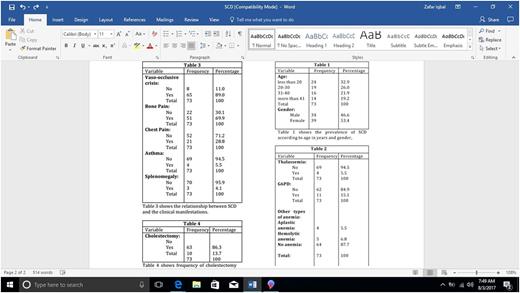Abstract

Introduction: Sickle cell disease (SCD) is an autosomal inherited structural disorder of hemoglobin which leads to vaso-occlusive, hematological and infectious crises, including stroke as one of the common complications. Eastern province of Saudi Arabia is known to have the highest prevalence of sickle cell anemia in the world, though resulting disease is mild. The aim of this study is to determine the characteristics of sickle cell patients in Al Asha, Eastern province of Saudi Arabia in order to determine factors ameliorating this disease in the area.
Material and Methods:
A total of 73 patients were included in the study. Data was collected by a questioner, which was composed of: Identity variables (MRN), social demography (age, gender), clinical manifestations (presence of co-morbidities), and laboratory results of hemoglobin (Hb) electrophoresis of sickle cell patients. Data has been analyzed by SPSS version 22.
Results:
Male to female ratio was 34:39. Moreover, SCD was more prevalent in females than males.Furthermore, SCD individuals less than 20 years reported as the highest prevalence among all age groups. Hemoglobin electrophoresis pattern in sickle cell patients were found to be: Hb A2 (2.26%) ± 1.005, Hb F (21.45%) ± 9.33, Hb S (76.27%)±8.73; Hb A1 was not detected. G6PD deficiency, thalassemias, aplastic anemia and hemolytic anemia with found in 11(15.1%), 4 (5.5%), 4 (5.5%) and 5 (6.8%) of patients. One of the world highest levels of HbF were detected in our SCD patients. Patients with high HbF levels and/or having G6PD deficiency had the milder form of SCD.
Discussion & Conclusions:
In this study, we found world highest Hb F levels in comparison to international normal range of Hb F in SCD patients which is unique to Saudi population. The study reflects that patients with SCD have vaso-occlusive crisis as the most common clinical manifestation followed by bone pain, chest pain, asthma and splenomegaly. We found an interesting case of a patient with β-Thalassemia trait and G6PD deficiency in addition to SCD. Almost 13.7% of all SCD patients had cholesteatoma. Although there are conflicting reports about effect of G6PD deficiency in SCD, we found ameliorating effect of G6PD which may account for mild form of SCD in Al Ahsa region. Further studies are required to investigate the factors responsible for ameliorating effects of different factors in SCD patients from this region which may open up new windows to clinically manage this disease in Saudi Arabia.
Saglio: Pfizer: Consultancy, Honoraria; BMS: Consultancy, Honoraria; Incyte: Consultancy, Honoraria; Roche: Consultancy, Honoraria; Ariad: Consultancy, Honoraria; Ariad: Consultancy, Honoraria; Novartis: Consultancy, Honoraria; Roche: Consultancy, Honoraria.
Author notes
Asterisk with author names denotes non-ASH members.

This icon denotes a clinically relevant abstract


